|
|
|
|
 |
BIRDS: Blackbirds |
|
|
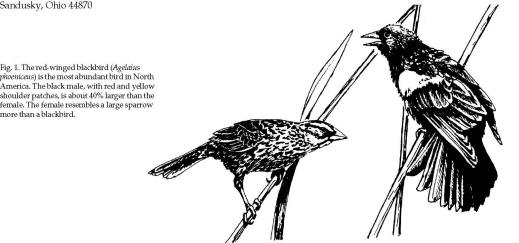
Fig. 1. The red-winged
blackbird
Introduction
The term blackbird loosely
refers to a diverse group of about 10 species of North
American birds that belong to the subfamily Icterinae.
In addition to blackbirds, this subfamily includes
orioles, meadowlarks, and bobolinks. The various species
of blackbirds have several traits in common. The males
are predominantly black or iridescent in color. All
blackbirds have an omnivorous diet consisting primarily
of grains, weed seeds, fruits, and insects. The relative
proportions of these food groups, however, vary
considerably among species. Outside of the nesting
season, blackbirds generally feed in flocks and roost at
night in congregations varying from a few birds to over
one million birds. These flocks and roosting
congregations are sometimes comprised of a single
species, but often several species mix together.
Sometimes they are joined by non-blackbird species,
notably European starlings (Sturnus vulgaris) and
American robins (Turdus migratorius).
The species also have many
important differences in their nesting biology,
preferred foods, migration patterns, and their damage
and benefits to agriculture. Summarized below for each
of seven species of blackbirds is information on
identification, geographic range, preferred habitats,
feeding habits, general biology, and damage.
Red-winged Blackbird (Agelaius phoeniceus)
Identification
The male, a little smaller
than a robin, is black with red and yellow shoulder
patches. The smaller female is brownish, resembling a
large sparrow (Fig. 1).
Range and Habitat
An abundant nester
throughout much of North America, the red-winged
blackbird nests in hayfields, marshes, and ditches.
Large flocks feed in fields and bottomlands. Redwings
winter in the southern United States.
Food Habits and General Biology
Insects are the dominant
food during the nesting season (May through July), with
the diet shifting predominantly to grain and weed seeds
in late summer through winter. Males and females often
forage in separated flocks, with females being more
insectivorous than males. Except during nesting season,
redwings congregate in large nighttime roosts in marshes
or woods containing up to several million birds. Annual
survival rate is only about 50% to 60%. This high
mortality rate is offset by a reproductive rate of 2 to
4 young fledged per female per year. Females have 3 to 5
eggs in their open-cup nests made of grasses and other
vegetation. Eggs hatch after 12 days of incubation; the
young grow rapidly and are ready to fledge about 10 days
later. Females will often renest if their initial nest
is destroyed.
Damage to Crops
Red-winged blackbirds can
cause considerable damage to ripening corn, sunflower,
sorghum, and oats in the milk and dough stages, and to
sprouting and ripening rice. These birds provide some
benefits by feeding on harmful insects, such as rootworm
beetles and corn earworms, and on weed seeds, such as
Johnson grass.
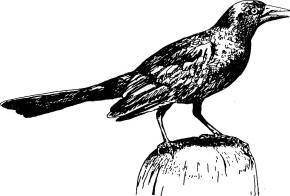 Common
Grackle (Quiscalus quiscula) Common
Grackle (Quiscalus quiscula)
Fig. 2. The common grackle
(Quiscalus quiscula) is an iridescent blackbird, larger
than a robin, with a long, keel-shaped tail.
Identification
An iridescent blackbird
larger than a robin, the common grackle has a long
keel-shaped tail. The male, slightly larger than the
female, has more iridescence on the head and throat
(Fig. 2).
Range and Habitat
A common nester throughout
North America east of the Rockies, the common grackle
nests in shelterbelts, farmyards, marshes, and towns.
Flocks feed in fields, lawns, woodlots, and bottomlands.
These birds winter in the southern United States, often
in association with redwings, cowbirds, and starlings.
Food Habits and General
Biology
The common grackle’s diet
is somewhat similar to that of the redwing, but the
grackle is more predatory. Its diet occasionally
includes small fish, field mice, songbird nestlings, and
eggs. Grackles have a larger, stronger bill than
redwings, allowing them to feed on acorns and other tree
fruits in winter. Grackles often roost with redwings,
but are more partial to roosting sites in upland
deciduous or pine trees. Reproductive and survival rates
are similar to redwings.
Damage to Crops
Damage is similar to that
of redwings; however, grackles will feed on mature field
corn in the dent stage, removing entire kernels from the
cob. Also, grackles will pull up sprouting corn.
Great-tailed Grackle (Quiscalus mexicanus)
Identification This
species is similar to the common grackle but with a much
larger tail. The male is slightly smaller than a crow;
the female is smaller and browner than the male.
Range and Habitat
An abundant year-round resident in coastal and
southern Texas, the great-tailed grackle nests in
colonies in shrubs or trees, sometimes in association
with herons and egrets. The flocks feed around farms,
pastures, and parks.
Food Habits and General
Biology
The diet is omnivorous: insects, aquatic organisms,
eggs from nesting birds, fruits, and grains.
Reproductive and survival rates are similar to those of
redwings.
Damage to Crops
These birds damage all
types of fruits and melons, although the loss is
generally minor. In recent years, however, their damage
to citrus crops in localized areas of the lower Rio
Grande Valley of Texas has been substantial. Great-tails
peck the citrus fruit skin, creating blemishes or holes.
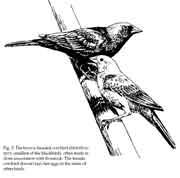 Brown-headed
Cowbird (Molothrus ater) Brown-headed
Cowbird (Molothrus ater)
Identification
The cowbird is the
smallest blackbird. The male is black with a brown head
and the female is gray. Both sexes have sparrowlike
bills (Fig. 3).
Fig. 3. The brown-headed
cowbird (Molothrus ater), smallest of the blackbirds,
often feeds in close association with livestock. The
female cowbird (lower) lays her eggs in the nests of
other birds.
Range and Habitat
Cowbirds occur in spring
and summer throughout much of North America. Flocks feed
in pastures and feedlots, and are often associated with
livestock. Cowbirds winter in the central to southern
United States, often roosting with redwings, grackles,
and starlings.
Food Habits and General
Biology
The diet of cowbirds
consists predominantly of weed seeds and grains, and
less than 25% insects. Cowbirds do not build nests or
incubate eggs; the female lays her eggs in nests of
other songbirds, the only North American songbird to do
so. Females deposit 1 or sometimes 2 eggs per host nest,
laying up to 25 or more eggs per nesting season.
Damage to Crops
This species can cause
damage to ripening sorghum, sunflower, and millet.
Cowbirds consume some livestock feed, but often glean
waste grain and seed from dung. Overall damage is
usually minor.
Yellow-headed Blackbird (Xanthocephalus xanthocephalus)
Identification
A robin-sized bird, the
male has a striking appearance with his black body,
conspicuous yellow head and breast, and a white wing
patch in flight. The female is smaller and browner, with
a yellowish throat and breast.
Range and Habitat
Yellowheads are locally
abundant nesters in deep-water marshes of the northern
Great Plains and western North America. They feed in
agricultural fields, meadows, and pastures during late
summer and fall, sometimes in association with redwings
or other blackbirds. They winter farther south than
other blackbirds, primarily in Mexico.
Food Habits and General
Biology
The diet is similar to
that of redwings; yellowheads eat primarily insects
during the nesting season and grains and weed seeds at
other times. An early An early migrant, the yellowhead
leaves the northern plains by September. Survival and
reproductive rates are similar to those of redwings.
Damage to Crops
Yellowheads cause
localized but generally minor damage to ripening corn,
sunflower, and oats, often in association with redwings.
They often leave the northern prairie regions by the
time corn and sunflower are ripening in autumn.
Brewer’s
Blackbird (Euphagus cyanocephalus)
Identification
A robin-sized bird, the
male is all black with whitish eyes; the female is
brownish gray with dark eyes.
Range and Habitat
A familiar bird in the
northern Great Plains and western North America, the
Brewer’s blackbird nests in a diversity of habitats. It
prefers pastures, lawns, and agricultural lands for
feeding. It is a winter migrant in the central and
southern Plains states, sometimes roosting with other
blackbird species.
Food Habits and General
Biology
The diet is about
two-thirds grain and weed seeds, and one-third insects
and other animal matter. They feed in flocks on waste
grain and weed seeds and nest in colonies. Reproductive
and survival rates are similar to those of redwings.
Damage to Crops
Brewer’s blackbirds cause
generally minor damage to oats, fruit crops, and
livestock feed and consume large numbers of noxious
insects during the summer months.
Rusty Blackbird (Euphagus carolinus)
Identification
Similar to Brewer’s
blackbird, its fall and winter plumage has a rusty
coloration.
Range and Habitat
Rusty blackbirds nest in
northern swamps and muskegs (bogs) throughout Canada,
Alaska, and northern New England. They migrate in winter
to the southern United States from the Atlantic coast to
east Texas.
Food Habits and General
Biology
The diet of rusty
blackbirds is more insectivorous than that of other
blackbirds. Over 50% of their food is animal matter.
Grain (gleaned from harvested fields in fall and
winter), weed seeds, and tree fruits are also eaten. In
winter, rusty blackbirds prefer swampy areas and river
bottoms. They often roost with other blackbird species.
Damage to Crops
This species does little
damage to crops.
Damage Identification and Assessment
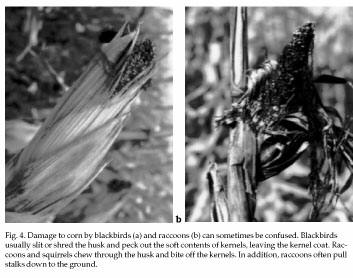 Blackbird
damage to agricultural crops is often readily
discernable because of the conspicuousness of the flocks
of birds and the visible signs of the damage. However,
correct identification of the species of birds in the
agricultural field is important, along with evidence
that the birds are actually feeding on the crop. For
example, starlings superficially resemble blackbirds and
sometimes feed in cornfields, yet they usually feed on
concentrations of insects such as armyworms, doing
little damage to corn. Also, red-winged blackbirds will
often be attracted to agricultural fields, such as corn,
initially to feed on rootworm beetles and other insect
pests. They will not damage the crop itself until the
grain has reached the milk stage. Blackbirds often
forage in newly planted grain fields such as winter
wheat, feeding on previous crop residue, weed seeds, and
insects without bothering the sprouting grain. Blackbird
damage to agricultural crops is often readily
discernable because of the conspicuousness of the flocks
of birds and the visible signs of the damage. However,
correct identification of the species of birds in the
agricultural field is important, along with evidence
that the birds are actually feeding on the crop. For
example, starlings superficially resemble blackbirds and
sometimes feed in cornfields, yet they usually feed on
concentrations of insects such as armyworms, doing
little damage to corn. Also, red-winged blackbirds will
often be attracted to agricultural fields, such as corn,
initially to feed on rootworm beetles and other insect
pests. They will not damage the crop itself until the
grain has reached the milk stage. Blackbirds often
forage in newly planted grain fields such as winter
wheat, feeding on previous crop residue, weed seeds, and
insects without bothering the sprouting grain.
Blackbird damage is also
sometimes confused with other forms of loss. Raccoon and
squirrel damage to corn can be mistaken for blackbird
damage (Fig. 4). Also, seed shatter in sunflower caused
by wind may resemble bird damage; however, the
difference can usually be detected by examining heads
for the presence or absence of bird droppings and by
looking on the ground for hulls or whole seeds. Careful
observation of the birds in the field and a little
detective work will usually result in the correct
identification of damage.
To estimate accurately the
amount of blackbird damage in an agricultural field,
examine at least 10 locations widely spaced throughout
the field. For example, if a field has 100 rows and is
1,000 feet (300 m) long, walk staggered distances of 100
feet (30 m) along every 10th row (for example, 0 to 100
feet [0 to 30 m] in row 10, 101 to 200 feet [31 to 60 m]
in row 20, and so on). In each of the 100-foot (30-m)
lengths, randomly select 10 plants and visually estimate
the damage on the head or ear of each plant to the
nearest 1% (for instance, 2% destroyed, 20% destroyed).
For corn, six kernels usually represent about 1% of the
corn on an ear; for sunflower, it may be easiest to
visually divide the head into four quarters and then
estimate the percentage of seeds missing. When finished,
simply determine the average damage for the 100 plants
examined. This will give an approximation of the percent
loss to the field. Multiplying the percent loss by
expected yield can give a rough estimate of yield loss.
In small grains, such as rice, estimates of loss are
more difficult to obtain. One possibility is to simply
compare the yields from plots in damaged and undamaged
sections of a field.
Legal Status
Blackbirds are native
migratory birds, and thus come under the jurisdiction of
the Federal Migratory Bird Treaty Act, a formal treaty
with Canada and Mexico. Blackbirds are given federal
protection in the United States. They may be killed only
when found “committing or about to commit depredations
upon ornamental or shade trees, agricultural crops,
livestock, or wildlife, or when concentrated in such
numbers and manner as to constitute a health hazard or
other nuisance,” as stated in federal laws regarding
migratory birds (50 CFR 21). Some states have additional
restrictions on the killing of blackbirds.
Damage
Prevention and Control Methods
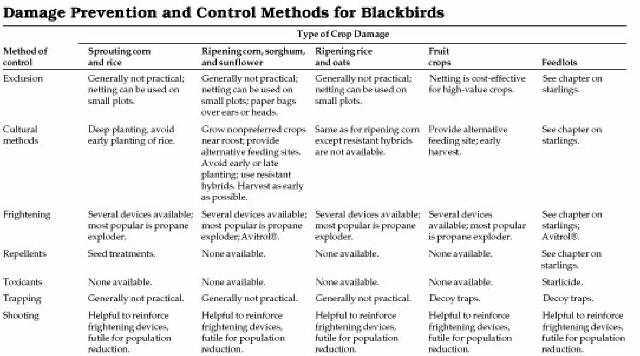
Exclusion
Exclusion of blackbirds
from agricultural crops is practical only for small
gardens, experimental plots, and high-value fruit crops.
Use lightweight netting to cover trees, bushes, or small
plots. Protect individual ears of sweet corn in garden
plots by placing paper bags over them after the silk has
turned brown.
Cultural Methods and Habitat Modification
Most economically severe
blackbird damage to agricultural crops occurs in fields
within 5 miles (8 km) of roosts. Thus, one strategy is
to plant nonattractive crops—such as soybeans, wheat,
potatoes, or hay—in fields within a few miles of a
roost. If crops vulnerable to damage, such as corn or
sunflower, are planted near a roost, alternative feeding
sites should be made available to reduce the feeding
pressure on these cash crops. Delaying the plowing or
tilling of previously harvested cropland near roosts to
provide alternative feeding sites is one strategy to
reduce damage to maturing crops. Also, fields near
roosts should not be planted unusually early or late so
that they mature in isolation from other fields in the
area. In general, as alternative feeding sites decline,
maturing grain or sunflower fields become more
attractive to blackbirds, and keeping them out becomes
more difficult.
Experimental programs are
under way in sunflower production areas of the northern
plains to thin out dense stands of cattails in marshes
where large numbers of blackbirds roost. A registered
herbicide (Rodeo®) is applied in swaths to about 70% of
the marsh. Thinning the cattail stands decreases
blackbird roosts in the marsh and increases use by
waterfowl for nesting and other activities.
Damage to sprouting rice
fields planted near blackbird roosts in Louisiana and
Texas can be substantially reduced by delaying planting
until April. By this time, the large flocks of migrant
blackbirds will have left for their northern nesting
areas.
The timing of harvest can
be very important in reducing damage to fields from
flocks of blackbirds. For example, redwings inflict most
damage to sweet corn at the time of fresh-market
harvest, when the corn enters the milk stage. Timely
harvest of sweet corn can substantially reduce damage.
Although field corn generally becomes unattractive to
birds when the kernels mature, sunflower, sorghum, and
rice continue to be attractive after they mature and
thus should be harvested as soon as possible.
Hybrids of corn with long
husk extension and thick husks are more resistant to
damage than other hybrids. Sorghum that contains a high
tannin content is also less preferred than low-tannin
varieties. For sunflower, birds prefer oil seed
cultivars over the confectionery cultivars. Using
sunflower cultivars with heads that turn downward as
they mature and seeds with thick hulls should also help
reduce feeding by blackbirds.
Frightening
The use of frightening devices can be quite
effective in protecting crops from flocks of blackbirds.
Their use also requires hard work and long hours for the
farmer, who needs to be persistent and innovative to
keep one step ahead of the birds. Devices need to be
employed especially in the early morning and in late
afternoon when the birds are most actively feeding.
Crops such as sweet corn, which are vulnerable to
blackbirds for only a few days before harvest, may not
be too difficult to protect; however, the task becomes
more formidable for crops such as sunflower and sorghum,
which may be vulnerable for up to six weeks. Propane
exploders (some with timers that automatically turn them
on and off each day) are the most popular frightening
devices. In general, use at least one exploder for every
10 acres (4 ha) of crop to be protected. Elevate
exploders on a barrel, stand, or truck bed to “shoot”
over the crop, and move them around the field every few
days. In addition, reinforce this technique occasionally
with other scare devices. By shooting a .22 caliber
rifle just over the top of a crop, a person on a stand
or truck bed can frighten birds from fields of 40 acres
(16 ha) or more. Obviously, care must be taken when
shooting in this manner, and the use of limited range
cartridges is recommended. Also effective are shell
crackers, 12-gauge shotgun shells containing fire
cracker projectiles that explode after traveling up to
150 yards (135 m). Shooting birds with a shotgun, using
standard bird shot, often can kill a few birds and
reinforce other scare devices. This technique, however,
usually is not as effective in moving birds as the other
devices that have greater range. Thus, a shotgun patrol
should not be used as the sole means of frightening
birds.
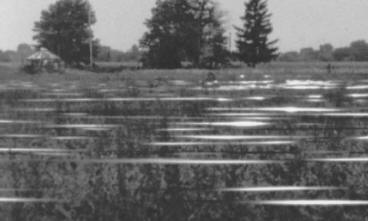
Fig. 5. Mylar reflecting
tape strung above the vegetation can reduce blackbird
feeding activity in agricultural fields.
A variety of other
bird-frightening devices, including electronic noise
systems, helium-filled balloons tethered in fields,
radio-controlled model planes, reflecting tapes made of
mylar (Fig. 5), tape-recorded distress calls for birds,
and various types of scarecrows, are also occasionally
used to rid fields of blackbirds. The effectiveness of
these devices is highly variable, depending on the
persistence of the operator, the skill used in employing
a device, the attractiveness of the crop, the number of
birds, and the availability of alternate feeding sites.
As mentioned with regard to propane exploders, birds
tend to adjust or adapt to frightening devices. It is
usually best to use two or more devices than to rely on
a single device.
Avitrol® is a registered
chemical frightening agent for blackbirds in corn and
sunflower fields. One out of every 100 particles of
cracked-corn bait is treated with the chemical,
4-amino-pyridine. The bait is applied to fields in
swaths, often by airplane, at the rate of 3 pounds per
acre (3.3 kg/ha) to one-third of the field. The
ingestion of one or more treated particles by a
blackbird induces erratic flight, distress calls, and
usually death. This behavior often causes the remaining
birds in the flock to leave the field.
Careful consideration must
be given to the timing of initial and repeat baitings.
Begin baitings when birds first initiate damage, and
repeat as necessary, typically at 5- to 7-day intervals.
Dense weed populations that hide bait, ground insects
such as crickets that eat bait, and excessive rainfall
can contribute to making the product ineffective.
Repellents
No bird repellents are currently registered for
maturing grain, sunflower, or fruit crops. Several
seed-treatment repellents such as Ro-pel® (active
ingredient is benzyl diethyl ammonium saccharide) and
Sevana Bird Repellent (ground garlic and pepper) have
been registered to reduce bird damage to freshly planted
and sprouting corn and other crops. However, the
registration status of these products changes
continually; thus, check with county extension agents or
USDA-APHIS-ADC biologists for products currently
registered.
Toxicants
Starlicide is a registered toxicant for blackbirds
and starlings in feedlot situations. The active
ingredient, 3-chloro-p-toluidine hydrochloride, is
incorporated into pelletized bait at a concentration of
0.1% and sold commercially under the trade name
Starlicide Complete®. Starlicide Technical® (98% active
ingredient), which can be custom-mixed with livestock
feed or other bait material, is also available through
the USDA-APHIS-ADC Program. Starlicide Technical® can be
used only by or under supervision of ADC employees.
Starlicide is a
slow-acting toxicant; birds usually die 1 to 3 days
after feeding. Baiting programs are most successful in
winter, especially with snow cover present, when
alternate foods are scarce. A successful program
generally requires a period of prebaiting with nontoxic
bait to accustom the target blackbirds and starlings to
feed at specific bait sites inaccessible to livestock in
the feedlot. Monitoring to ensure that nontarget birds
such as doves, song birds, and barnyard fowl do not feed
at bait sites is essential. See the chapter Starlings
for more details on the use of Starlicide.
Trapping
Certain species of blackbirds, particularly
redwings, brown-headed cowbirds, and common grackles,
often can be readily trapped in decoy traps. Consult a
state wildlife official, such as a conservation officer
or game warden, before putting a decoy trap into
operation. A decoy trap is a large (for instance, 20 x
20 x 6 feet [6 x 6 x 1.8 m]) poultry wire or net
enclosure containing 10 to 20 decoy birds, food, and
water (Fig. 6). Birds enter the trap through an opening
(often 2 x 4 feet [0.6 x 1.2 m]) in the top of the cage
that is covered with 2 x 4-inch (5 x 10-cm) welded wire.
The blackbirds can fold their wings and readily drop
through the openings to the food (generally cracked
corn, millet, or sunflower seeds) below. A small (for
example, 2 x 2 x 3 feet [0.6 x 0.6 x 0.9 m]) gathering
cage with a sliding door attached to an opening at an
upper corner of the trap can be used to collect trapped
birds. A corralling baffle running about two-thirds the
length of the trap can aid in driving the birds into the
gathering cage.
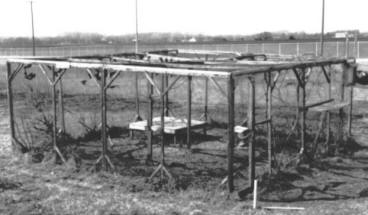
Fig. 6. A typical
blackbird and starling decoy trap showing elevated feed
platform in center of trap and gathering cage on the far
right. Birds enter the trap through a 2 x 4-foot (0.6 x
1.2-m) opening covered with 2 x 4-inch (5 x 10-cm)
welded wire located directly above the feed platform.
A decoy trap often catches
10 to 50 blackbirds and starlings per day and
occasionally up to 300 when located near a large roost.
Obviously, the decoy trap is of questionable value in
trying to reduce large roosting populations and damage
to the surrounding agricultural fields. These traps,
however, can be used to temporarily reduce local
populations of blackbirds in special situations. For
example, decoy traps have been used successfully in a
six-county area of Michigan since the 1970s to reduce
cowbird populations during the nesting season. This
control was initiated to increase the nesting success of
the Kirtland’s warbler (Dendroica kirtlandii), an
endangered species whose nests are often used by
cowbirds for laying their own eggs.
Each year about 3,500
cowbirds have been captured by decoy traps in this area
of Michigan. Decoy traps might also be successful in
reducing localized populations around feedlots or fruit
crops.
Any nontarget songbirds
accidentally captured in a decoy trap should be released
immediately. Blackbirds to be disposed of should be
killed humanely. They can be transferred from the
gathering cage to a cardboard box or canvas-covered cage
and asphyxiated with carbon dioxide gas. All dead birds
should be examined for bands, and any bands found should
be reported. One option for disposal that should not be
overlooked is culinary. Blackbirds, being primarily
grain eaters, make good food for humans! Recipes for
quail or dove also work well for blackbirds.
Shooting
As discussed under Frightening, shooting to kill
with a shotgun is most effective when used occasionally
to supplement or reinforce other scare devices. By
itself, shooting with a shotgun is not cost-effective in
frightening blackbirds from large agricultural fields,
and it is totally ineffective as a means of reducing
populations. Any killed birds should be examined for
bands.
Economics of Damage and Control
Superficial surveys of
agricultural fields often overestimate blackbird damage
and thus exaggerate the overall severity of the economic
threat for one of four reasons: (1) the conspicuousness
of blackbird flocks tends to heighten the awareness of
bird damage compared with other more subtle forms of
loss caused by weeds, insects, other pests, and
harvesting; (2) the eye naturally seeks out the
conspicuously bird-damaged plants; (3) bird damage is
often most severe along field edges where an observer is
most likely to check; and (4) raccoon, other mammal, or
wind damage is sometimes mistaken for bird damage (see
the section Damage Identification and Assessment). This
is not to downgrade the problem of blackbird damage in
agriculture; damage can be economically severe on
occasion and quite frustrating to the farmer when relief
is not readily available. It is important, however, to
obtain objective estimates of damage levels likely to
occur, for only then can intelligent decisions be made
regarding the amount of money and effort to be invested
on control. The final decision on control measures must
take into account the value of the crop, cost of
control, and the degree of effectiveness of the control
measure in relation to the probable levels of damage.
Studies during the past
two decades concerning blackbird damage to various crops
such as corn and sunflower indicate that on statewide or
regional bases, overall mean damage is low, generally
less than 1% of the crop. If all farmers received less
than 1% damage, there would be little concern; however,
the damage is not equally distributed. While most
farmers escape economically serious damage, a few
farmers receive serious damage. For example, in North
Dakota, South Dakota, and Minnesota in 1979 and 1980,
overall loss of sunflower to blackbirds was estimated to
be only 1.2% of the crop. Yet, 2% of the fields received
more than 10% loss. Only in these relatively few fields
that sustain high levels of damage can control measures
generally be cost-effective.
While accurate prediction
of damage is often impossible to obtain, knowledge of
the location of a field in relation to traditional
roosting sites often provides the basis for a sound
estimate of potential damage. For example, studies of
blackbird damage to ripening corn in Ohio have revealed
that almost all losses exceeding 5% of the crop have
occurred in fields within 5 miles (8 km) of marsh
roosts.
Objective estimates of
damage levels in previous years for the same or nearby
fields are another means of predicting future damage
levels, because bird damage is fairly consistent from
year to year within a locality. This information also
provides a good baseline for evaluating the
effectiveness of management strategies. Of course, it is
important that estimates be objective and apply to the
entire field.
Acknowledgments
Figures 1 through 3 by
Emily Oseas Routman.
Figures 4, 5, and 6 by the
author.
For Additional Information
Bent, A. C. 1965. Life
histories of North American blackbirds, orioles,
tanagers, and allies. Dover Publ., Inc., New York. 549
pp. and 37 plates.
Besser,
J. F. 1978. Birds and sunflowers. Pages 263-278 in J. F.
Carter, ed. Sunflower science and technology. Amer. Soc.
Agron., Crop Sci. of Amer., Soil Sci. Soc. of Amer.,
Inc., Madison, Wisconsin.
Dolbeer,
R. A. 1981. Cost-benefit determination of blackbird
damage control for cornfields. Wildl. Soc. Bull.
9:43-50.
Dolbeer,
R. A. 1990. Ornithology and integrated pest management:
the red-winged blackbird (Agelaius phoeniceus). Ibis
132:309-322.
Robbins, C. S., B. Bruun,
and H. S. Zim. 1983. Birds of North America: a guide to
field identification. Golden Press, New York. 360 pp.
White, S. B., R. A.
Dolbeer, and T. A. Bookhout. 1985. Ecology,
bioenergetics, and agricultural impact of a
winter-roosting population of blackbirds and starlings.
Wildl. Monogr. 93. 42 pp.
Wilson, E. A., E. A.
LeBoeuf, K. M. Weaver, and
D. J. LeBlanc. 1989.
Delayed seeding for reducing blackbird damage to
sprouting rice in southwestern Louisiana. Wildl. Soc.
Bull. 17:165-171.
Editors
Scott E. Hygnstrom; Robert
M. Timm; Gary E. Larson
01/08/2007
Special
thanks to:
Clemson University
|